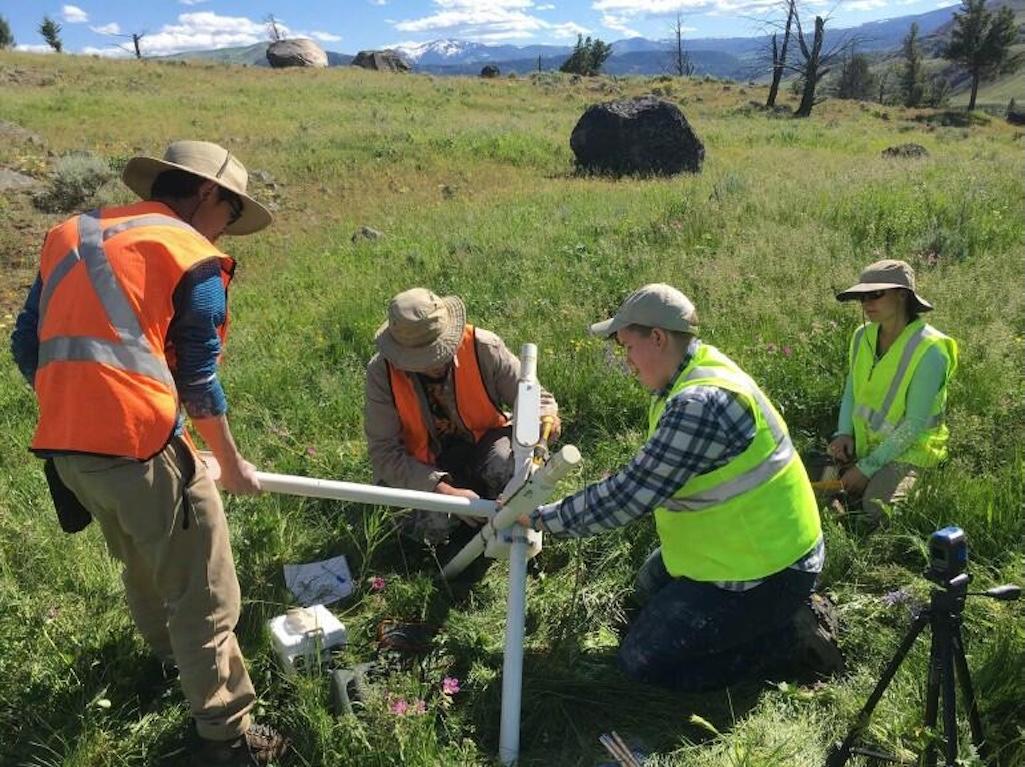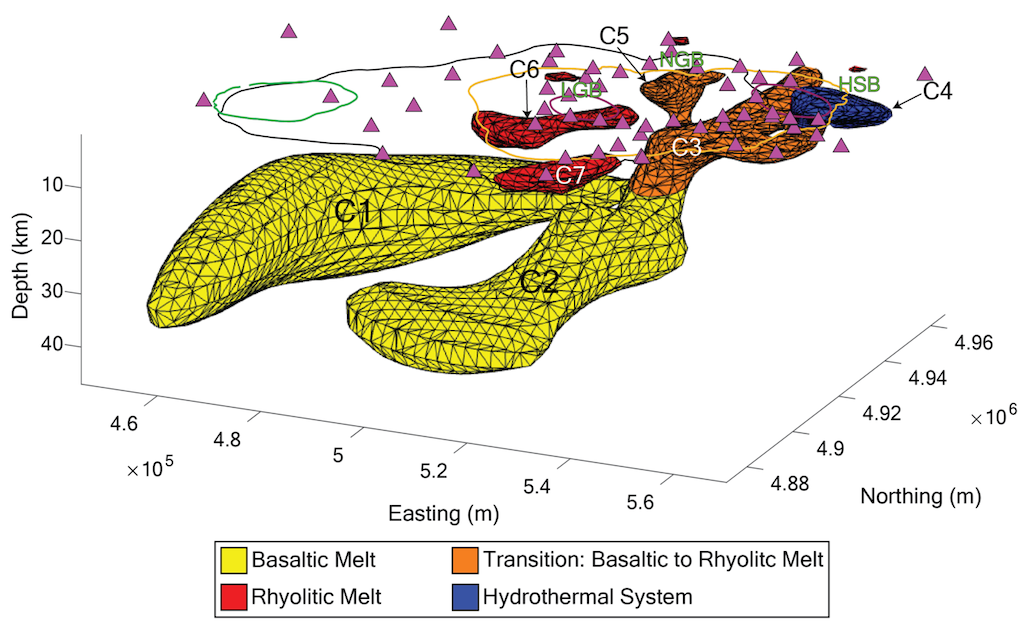
Field crew from Oregon State University and University of Wisconsin-Madison install a magnetotelluric site within Yellowstone National Park/USGS
Editor's note: Yellowstone Caldera Chronicles is a weekly column written by scientists and collaborators of the Yellowstone Volcano Observatory. This week's contribution is from Ninfa Bennington, geophysicist with the U.S. Geological Survey at the Hawaiian Volcano Observatory.
How can lightning and solar storms be used to map magma beneath Yellowstone? Through magnetotelluric imaging, which provides information about the amounts and locations of melt in the subsurface!
Yellowstone caldera is one of the largest volcanic systems in the world. Past volcanic activity at the caldera has ranged from the output of lava flows to the explosion of large volumes of ash, and the last eruption in the region—a lava flow—was over 70,000 years ago. In a recent study, USGS investigators with collaborators at Oregon State University and the University of Wisconsin-Madison used a tool called magnetotellurics to image where and how much magma is presently stored beneath Yellowstone caldera.
Magnetotellurics is a geophysical method that uses variations in the Earth’s naturally occurring electromagnetic field, typically caused by lightening and solar storms, as a signal for imaging the subsurface. The technique identifies structures within the Earth that are good conductors of electricity. Magma stored beneath the ground is an excellent electrical conductor. This makes magnetotellurics an ideal tool for mapping where magma is distributed beneath active volcanoes.
Using magnetotelluric data collected across Yellowstone caldera in the summers of 2017 and 2021, geophysicists modeled where magma is stored beneath the region to as deep as 47 kilometers (30 miles) below the surface. At shallow depths, roughly 4 to 11 kilometers (2.5 to 7 miles) below Yellowstone caldera, four distinct reservoirs of rhyolitic magma storage were identified. Rhyolite is a composition that is high in silica content and has fed both explosive eruptions and lava flows from the Yellowstone system over the past ~2 million years. Of the four rhyolitic reservoirs identified, three hold total volumes comparable to past small volcanic eruptions at Yellowstone. The volume of the fourth reservoir is similar to the Mesa Falls Tuff, which erupted during the formation of Henrys Fork caldera (the smallest of Yellowstone’s three large caldera-forming eruptions) about 1.3 million years ago.
The magma storage areas imaged by the magnetotelluric study are not completely molten, however, and instead consist of a mush of packed crystals interspersed with liquid rhyolitic magma. If those pockets of liquid magma are well connected and sufficient in volume, a volcanic eruption could occur. However, the magnetotelluric data indicate that the concentration of magma stored within each of these four reservoirs is too low to feed an eruption at present. In this sense, the results from the magnetotelluric study are very similar to studies of the Yellowstone magmatic system using seismic data, which also suggest an overall low proportion of liquid magma beneath the surface.

Schematic showing magma storage beneath Yellowstone caldera. Nested calderas resulting from the Huckleberry Ridge Tuff, Mesa Falls Tuff, and Lava Creek Tuff caldera forming eruptions are shown as solid black, green, and orange lines, respectively. C1 and C2 represent bodies of basaltic magma and C3 and C5-C7 represent rhyolitic magma bodies beneath Yellowstone caldera. Magnetotelluric stations occupied during experiment are shown as magenta triangles. Sour Creek and Mallard Lake resurgent domes are shown as purple lines. The locations of Lower Geyser Basin (LGB), Norris Geyser Basin (NGB), and Hot Springs Basin (HSB) are shown. Figure is from Bennington et al., "The progression of basaltic–rhyolitic melt storage at Yellowstone Caldera." Nature 637:8044 (2025), 97-102.
Seismic imaging of the Yellowstone system has also identified a deeper magma body, likely composed of basalt—Earth’s most primitive magma type and the heat engine that helps to generate and sustain the shallower rhyolite magma chamber. Magnetotelluric imaging also reveals the presence of the deeper basaltic magma, which appears to be directly connected to rhyolitic magma stored northeast of Yellowstone caldera but disconnected from rhyolite magma stored beneath the west part of the caldera. Without an underlying heat source, rhyolitic magma in western Yellowstone caldera will continue to cool, and rhyolite eruptions in this region will eventually cease. Northeast of the caldera, however, the direct connection between shallow rhyolitic magma and the underlying basaltic heat source will sustain and possibly grow the volume of magma in this region over hundreds of thousands of years. It is therefore possible that this region will be the locus of future rhyolitic eruptions in the Yellowstone region.
Not anytime soon, though. The magma stored beneath the surface of Yellowstone National Park exists in a mostly solid state and is probably not capable of erupting, not even as a lava flow—a result that is known thanks to the fascinating field of magnetotellurics!




 Support Essential Coverage of Essential Places
Support Essential Coverage of Essential Places






